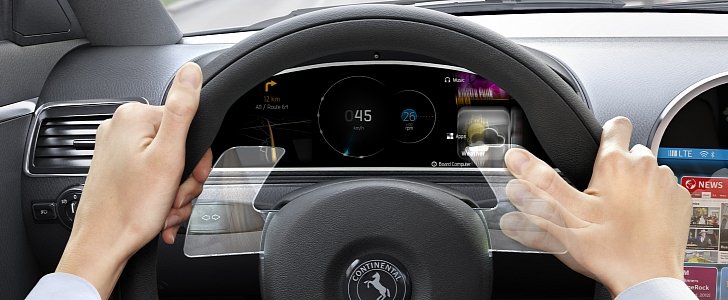Continental, a leading German automotive company that specializes in tires, brakes, safety, and powertrain systems, is upping the ante once again. The latest project the peeps at Continental are developing is a gesture-based control system.
The contraption featured in the photograph above intends to make life easier for the driver by stripping away buttons on the steering wheel. See those two transparent plastic panels? They can be operated by the driver’s thumbs, almost like a touchpad.
"With gestures in a clearly defined area on the steering wheel, we can minimize distraction and increase safety. This narrowing down also prevents the driver from unintentionally starting gesture-based control by means of their usual everyday gestures, and thus making unwanted selections," points out Ralf Lenninger, the head of strategy, system development, and innovation at the interior division of Continental. Care to guess what makes this system so easy to operate?
For example, the driver can accept an incoming call (or reject if the boss is calling on a Saturday morning) by moving their thumb up or down while keeping their hands on the steering wheel. These gestures aren’t only intuitive, but they’re familiar to smartphone users. A little wave of the hand offers the same result.
Continental's breakthrough technology can detect three other gestures, as in setting the navigation, browsing through apps, and starting the music player. Continental tells that the most important component of the gesture-based control system is the time-of-flight sensor, also known as a range imaging camera, integrated into the instrument cluster. The system is comprised of a 3D camera and a three-dimensional image sensor with the sole purpose of converting infrared signals detected by the sensor into a 3D image.
"The development of a holistic human-machine interface is crucial for further strengthening the driver's confidence in their vehicle. Building up this confidence, combined with an intuitive dialog between driver and vehicle is yet another important step on the road to automated driving, one that we are supporting with gesture-based control on the steering wheel," summarized Lenninger.
It's not known if the system will go into production in the future, but then again, never say never.
"With gestures in a clearly defined area on the steering wheel, we can minimize distraction and increase safety. This narrowing down also prevents the driver from unintentionally starting gesture-based control by means of their usual everyday gestures, and thus making unwanted selections," points out Ralf Lenninger, the head of strategy, system development, and innovation at the interior division of Continental. Care to guess what makes this system so easy to operate?
For example, the driver can accept an incoming call (or reject if the boss is calling on a Saturday morning) by moving their thumb up or down while keeping their hands on the steering wheel. These gestures aren’t only intuitive, but they’re familiar to smartphone users. A little wave of the hand offers the same result.
Continental's breakthrough technology can detect three other gestures, as in setting the navigation, browsing through apps, and starting the music player. Continental tells that the most important component of the gesture-based control system is the time-of-flight sensor, also known as a range imaging camera, integrated into the instrument cluster. The system is comprised of a 3D camera and a three-dimensional image sensor with the sole purpose of converting infrared signals detected by the sensor into a 3D image.
"The development of a holistic human-machine interface is crucial for further strengthening the driver's confidence in their vehicle. Building up this confidence, combined with an intuitive dialog between driver and vehicle is yet another important step on the road to automated driving, one that we are supporting with gesture-based control on the steering wheel," summarized Lenninger.
It's not known if the system will go into production in the future, but then again, never say never.






